“The Way It Looks Today: A Camera Tour of Church History Sites in Illinois,” Ensign, Sept. 1979, 34
Nauvoo
The Way It Looks Today:
A Camera Tour of Church History Sites in Illinois
In the Ensign’s continuing tour of Church history sites, we come to Nauvoo, Illinois, the most ambitious Latter-day Saint settlement in the East but only a prelude to the kingdom that would be built in the west. James L. Kimball, Jr., of the Church Historical Department accompanied photographer Jed Clark to sites in the Nauvoo area and provided material for the captions.

Aerial view of Nauvoo at dusk, looking west toward Iowa.
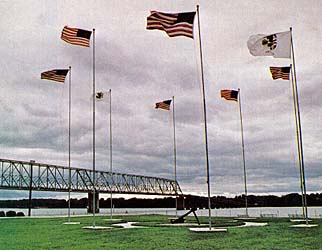
Quincy, Illinois, sheltered the Saints when they crossed the Mississippi River from Missouri.
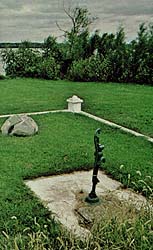
The Mormons stayed in army barracks on the site of Fort Des Moines in 1839.
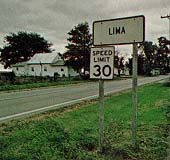
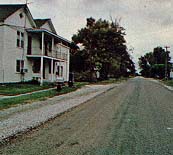
Lima, Illinois, where some Saints settled after the exodus from Missouri and where Eliza R. Snow taught school.
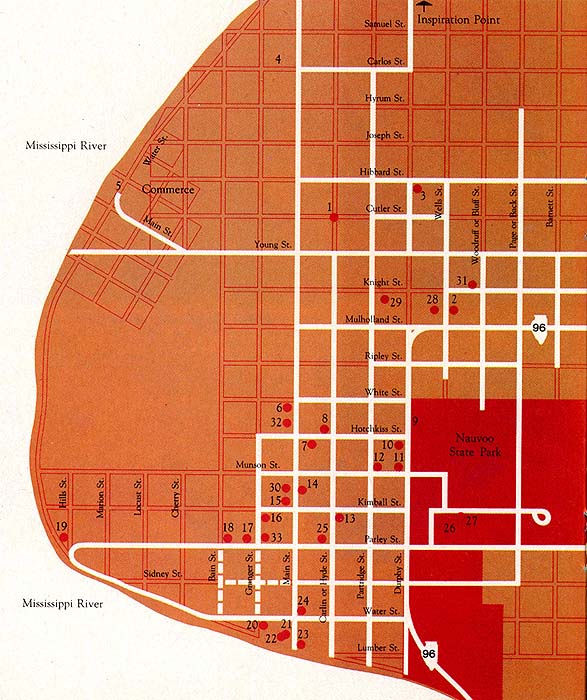
The City of Nauvoo
|
1. Nauvoo Visitors Center |
12. Restored Heber C. Kimball house |
23. Nauvoo House |
|
2. Nauvoo Temple site |
13. Restored Noble-Smith house |
24. Mansion House |
|
3. Nauvoo LDS Chapel |
14. Restored Jonathan Browning house |
25. Erastus Snow-Nathaniel Ashby double house |
|
4. Stone quarry for temple |
15. Times and Seasons printing complex |
26. Sunstone from Nauvoo Temple, in Nauvoo State Park |
|
5. Site of steamboat landing, town of Commerce |
16. Restored Brigham Young house |
27. Museum in Nauvoo State Park |
|
6. Masonic Hall (Cultural Hall) |
17. Reconstructed Webb wagon and blacksmith shop |
28. Grove for preaching services |
|
7. Windsor P. Lyon house, store, carriage house |
18. Reconstructed Seventies Hall |
29. Edward Hunter house |
|
8. Orson Hyde house |
19. One of Nauvoo’s ferry landings, ruins of James White house |
30. Sylvester Stoddard house |
|
9. Site of William Clayton house |
20. Foundation of Joseph Smith store |
31. Raymond Clark store |
|
10. Restored Wilford Woodruff house |
21. Joseph Smith Homestead |
32. Scovil Bakery |
|
11. Winslow Farr house (restored exterior) |
22. Graves of Joseph, Emma, and Hyrum Smith |
33. John Taylor site |
|
(Map used by permission of Nauvoo Restoration, Inc.) | ||

Nauvoo, viewed from the Iowa side, gleams at the Mississippi River’s edge.

The Iowa side at dusk is hazy across the Mississippi from the Illinois shore.

The Joseph Smith family may have sheltered in this log cabin behind the Joseph Smith Homestead while adding to the Homestead, their first home in Nauvoo. Reconstructed by the Reorganized Church of Jesus Christ of Latter Day Saints.

Twice each Sunday, meetings were held in this grove west of the temple. From the open windows of Edward Hunter’s home, Joseph Smith could “attend” services while in hiding.
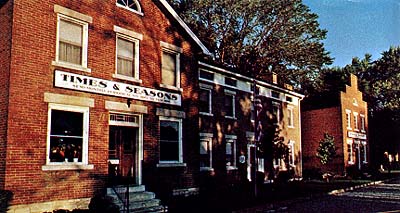
Times and Seasons complex where that newspaper, the Book of Mormon, the Doctrine and Covenants, a hymnbook, and several other books were published between 1839 and 1846.
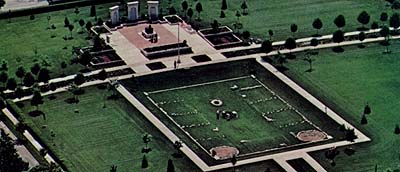
Aerial view of the temple block in Nauvoo looking east. The foundations have been excavated.
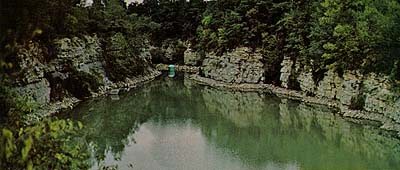
Portion of the quarry from which the Nauvoo Temple limestone was taken.
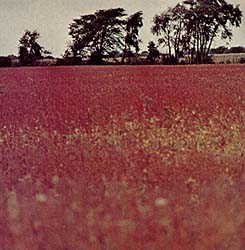
The 640-acre Joseph Smith farm, several miles east of Nauvoo, managed by Cornelius P. Lott.

The unpaved country road, like other nineteenth-century roads in the area, is in Macedonia, or Ramus (now known as Webster) twenty-two miles southeast of Nauvoo. With three hundred inhabitants, Macedonia rivaled Carthage, the county seat, for size. It was there that Joseph Smith gave the Saints the information that is now recorded in D&C 130 and D&C 131.

On New Year’s Day 1843, Joseph Smith and his companions, in Springfield for a judicial hearing, held services in this House of Representatives at the invitation of the Speaker of the House. Abraham Lincoln (chair marked by a shawl [not shown]) could have been in attendance.
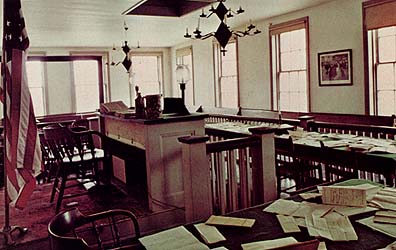
In the federal courtroom, since restored, Joseph Smith appeared before Judge Nathaniel D. Pope to quash Missouri’s attempt to have him extradited. The judge ruled the Missouri writ illegal.
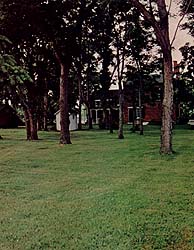
Heber C. Kimball’s red brick house as seen from the rear.

Front view of the reconstructed Webb blacksmith shop, one of the largest Nauvoo stores of its kind.

The Jonathan Browning house and workshop. A Kentucky native, Browning joined the Church near Quincy, invented one of the earliest repeating rifles, and fathered John Moses Browning, the Ogden, Utah, settler who invented the automatic machine gun.
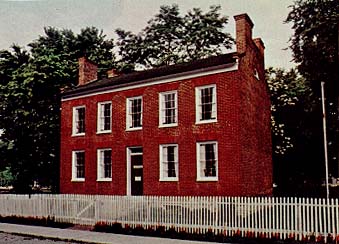
Wilford Woodruff home, front view.

Back view of Brigham Young’s handsome brick home.

This two-family dwelling on Hyde Street was the home of Erastus Snow (right) and Nathaniel Ashby (left), whom Brother Snow had converted in Massachusetts. Brother Ashby kept a cobbler shop in his home.
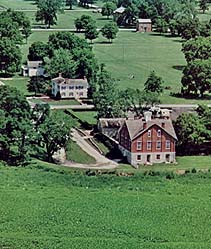
The Nauvoo House, maintained by the RLDS Church, is in the right foreground. The cream-colored building up the block is the Mansion House, in which Joseph lived for the last ten months of his life. The Homestead is in the trees to the left.
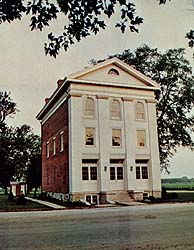
The Masonic Hall, scene of many civic meetings, plays, and the police headquarters.

[This] reconstructed Seventies’ Hall, built between 1843 and 1844, was used for lectures, classes, and worship services.
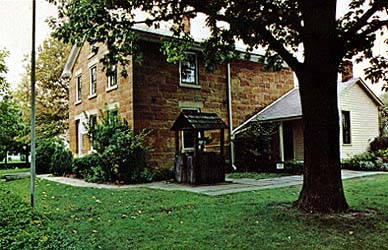
Carthage Jail where Joseph and Hyrum Smith were killed on 27 June 1844.

First floor of the jail where the prisoners spent their first night.
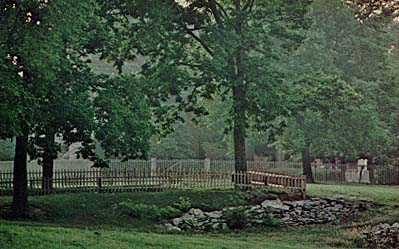
Smith family cemetery with stones marking the original sites of Joseph and Emma Smith’s graves. Also interred here are Lucy, Joseph, Sr., Hyrum, Don Carlos, and Samuel Smith; two of Joseph’s infant sons; and some family friends.
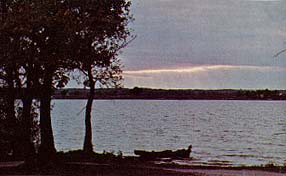
View of Montrose, Iowa, looking across the Mississippi from the site of the main Nauvoo ferry. Here the pioneers crossed the frozen river in the winter of 1846.
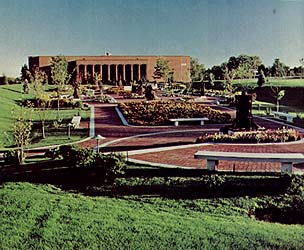
Visitors center with the garden of statues honoring the Relief Society, dedicated in the summer of 1978. President Ezra Taft Benson of the Quorum of the Twelve created the thousandth stake in the Church at Nauvoo on 18 February 1979.
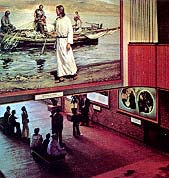
In the Nauvoo visitors center, visitors view a large reproduction of a painting of the Savior calling his apostles.
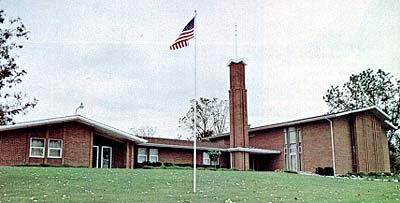
The first—and, so far, only—Latter-day Saint meetinghouse ever erected in Nauvoo was dedicated in 1969 by President Harold B. Lee.
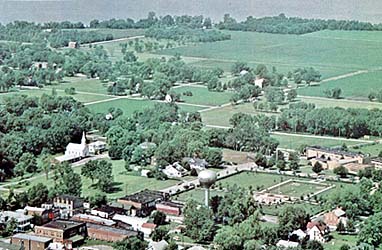
Aerial view of Nauvoo, with the temple lot in the lower right-hand corner. The Seventies’ Hall is in the upper left.
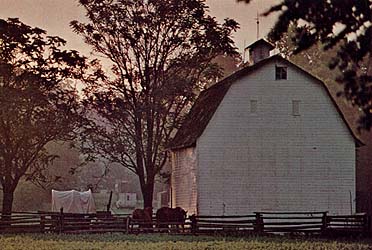
Today, this trim, modern barn stands beside the home of Orson Hyde, the apostle who dedicated Palestine for the return of the Jews and the building-up of Jerusalem.

Nauvoo visitors enjoy buggy rides not far from the spot where King Follett lived; in Brother Follett’s funeral sermon, Joseph Smith added significantly to doctrines about the nature of Godhood.
Photography by Jed Clark